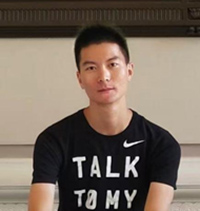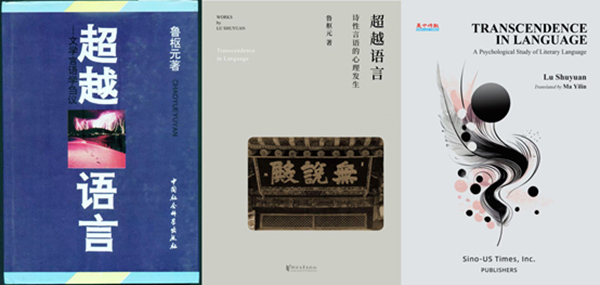美东时间2025年3月29日晚8时,美西时间3月29日下午5时,北京时间3月30日上午9时,来自美国和中国十几所知名高校的专家学者在线上齐聚一堂,共同参加由美国中美后现代发展研究院主办的过程哲学视域下的语言学研究暨鲁枢元教授语言学思想国际研讨会。兰州大学外国语学院教师、研究生马伊林、杨婧妮在发言中说,鲁枢元教授在《超越语言》中强调译者的文化责任与创造性工作。AI的引入使译者反思自身的身份问题,而这种身份是译者无法替代的。文学译者不再是单纯的语言转换者,而更像文化的解读者与再创作者。

以下是马伊林、杨婧妮发言全文:
AI时代的文学翻译
—— 兼谈《超越语言》的启示
马伊林、杨婧妮
作为《超越语言》英文版译者,本人承蒙鲁枢元教授和《美中时报》出版社总编辑张来民老师的鼓励与信任!感谢国内外诸多专家对于译著的审阅及其所提出的宝贵意见。
随着AI技术的迅猛发展,文学翻译领域正经历着前所未有的变革。AI翻译以其高效、迅速的特点,已经在新闻、科技文献等实用性文本的翻译中取得显著成效。然而,文学翻译涉及复杂的文化背景、语言风格、情感表达和作者个性,这些因素使其难以被完全机械化。鲁枢元教授对于文学语言心理层面的探究,能够为文学翻译的建构与实践提供重要的启迪,并帮助我们深入思考机器翻译的局限性以及人类译者的不可替代性。
一、AI文学翻译的局限性与挑战
1.文化与情感的缺失
鲁枢元教授指出,文学语言具有不可忽视的文化属性与情感色彩。而AI翻译主要依赖统计概率和算法模型,难以捕捉文学作品中蕴含的文化内涵和情感细节。文学作品中出现的地域文化、历史典故和隐喻意象,往往超出AI的理解能力,导致翻译结果流于表面,缺乏深度。
同时,文学创作是一种高度个性化和文化敏感的活动,作者在创作过程中常常融入自身的生活经验、思想情感和文化认同。AI无法理解和再现这种情感深度和文化复杂性,容易使翻译文本失去原作的温度与灵魂。
2.语言的多义性与创造性表达
鲁枢元教授指出,文学创作本质上是对语言极限的突破和探索。文学语言具有高度的模糊性和多义性,尤其在诗歌、小说中,作者常借助象征、隐喻、双关语等修辞手法以及语词之间奇妙的反应,带来“语言的狂欢”,创作出“只可意会”的崇高意境。
AI由于其依赖于已有语料库的学习,无法生成真正具有原创性和深刻性的翻译,难以传达文学语言中微妙的语感、隐含的情感波动以及深层次的“高峰体验”。
3.作者意图的理解与再现
文学创作过程中,作者的文化立场、情感归属以及思想建构往往是隐含的,需要译者进行艰辛地有效探寻。AI难以理解这些深层次意图,因此其翻译通常只能呈现表面的语言形式,无法捕捉文本中的深层意义与作者的创作意图,导致文学作品的精神内核被稀释或误读。
4.文本开放性与多重解读
文学作品通常具有文本开放性,允许多重解读与多维视角。鲁枢元教授指出,语言的意义在不同的文化语境中具有流动性和多义性。AI依赖于已有数据和概率模型,呈现出文本的单一解读模式,无法捕捉文本的复杂性与歧义性的“常读常新”之姿,关闭了文学作品的多重解读空间。
二、AI与人类译者的协作模式
1.AI辅助与人类审校的结合
在文学翻译中,AI可以作为人类译者的辅助工具,承担文本初步翻译、术语匹配和信息检索等基础性工作,而人类译者则负责对翻译文本进行深度理解、语境分析与文化补充,确保译文符合文学性与文化适配性。
2.机器与人类的互补性
AI善于处理大规模文本,负责数据处理与语料生成,适用于翻译前期的文本分析与语义匹配。人类译者具备情感理解、文化洞察与语言创造能力,能够弥补AI在文学性和文化再现方面的不足。两者结合可以提高翻译效率,同时确保文学作品的深度与审美价值。
3.译者角色的转变与提升
鲁枢元教授在《超越语言》中强调译者的文化责任与创造性工作。AI的引入使译者反思自身的身份问题,而这种身份是译者无法替代的。文学译者不再是单纯的语言转换者,而更像文化的解读者与再创作者。
AI时代的文学翻译既面临前所未有的机遇,也存在深刻的挑战。鲁枢元教授在《超越语言》中对语言的文化属性与情感表达的强调,为我们理解AI翻译的局限性与人类译者的独特性提供了深刻洞察。AI技术可以提升翻译效率,但难以完全再现文学作品的情感、文化与创造性表达。因此,文学翻译的未来应是AI与人类译者的协同共生,既利用AI的技术优势,又发挥人类译者的文化理解与创造力,共同推动文学翻译的深度与广度。

鲁枢元著:《超越语言》(初版),中国社会科学出版社1990年版
鲁枢元著:《超越语言》(修订版),浙江文艺出版社2023年版
Lu Shuyuan: TRANSCENDENCE INLANGUAGE A Psychological Study of Literary Language
Sino-US Times, Inc.1924
马伊林,1990年生,河南洛阳人,中国人民大学英语系与美国加州大学伯克利分校英语系联合培养博士,现任教于兰州大学外国语学院英语系,主要从事英美文学、比较文学以及文学翻译研究,近年来出版的著作包括:专著《诗人与帝国:威廉·华兹华斯诗歌研究》(中国社会科学出版社,2024年);译著《一瓶毒药》(汉译,上海文艺出版社,2025年待出)、《超越语言》(英译,Sino-US Times INC., Publishers,2024年),《错位》(汉译,上海文艺出版社,2023年)、《巅峰故事》(汉译,湖南人民出版社,2022年)。
Literary Translation in the Age of AI: Professor Lu Shuyuan’s Implications for Translators
Written by Ma Yilin & Yang Jingni
Translated by Ma Yilin & Yang Jingni
As the translator of the English edition of Transcendence in Language,I am deeply grateful for the encouragement and trust of Prof. Lu Shuyuan andDr. Zhang Laimin, Chief Editor of The Sino-US Times Inc., Publishers. Mysincere thanks also go to the numerous experts at home and abroad who havereviewed the translation and provided invaluable feedback.
AI translation, known for its efficiency and speed, has achieved remarkablesuccess in translating the specific texts, such as the news and scientifictext. However, literary text involves complex cultural contexts, linguisticstyles, emotional expressions, and the author’s individuality, making itchallenge to be fully translated with the only aid of AI. Professor Lu Shuyuan’spsychological study of literary language offers vital insights for theconstruction and practice of literary translation. It also prompts us to reflecton the limitations of AI translation and the irreplaceable role of humantranslators.
I. AI Translation’s Limitations on Literary Text
1.1 Loss of Culture and Emotion
Professor Lu emphasizes that literary language possesses an indispensablecultural attribute and emotional texture. AI translation, which primarilyrelies on statistical probabilities and algorithmic models, can be difficult tocapture the cultural connotations and emotional nuances embedded in literaryworks. Elements such as regional culture, historical allusions, andmetaphorical imagery often exceed AI’s comprehension capabilities, resulting insuperficial translations that lack depth.
Moreover, literary creation is a highly personalized and culturallysensitive activity. Authors often integrate their life experiences, emotionalexpressions, and cultural identities into their works. AI is incapable ofunderstanding and reproducing this emotional depth and cultural complexity,which can lose the warmth and soul of the original work.
1.2 Ambiguity and Creative Expression
According to Professor Lu, literary creation fundamentally represents abreakthrough and exploration of the limits of language. Literary language ischaracterized by a high degree of ambiguity and polysemy. In poetry andfiction, for instance, authors frequently employ rhetorical devices such assymbolism, metaphor, and wordplay, creating a “carnival of language” andproducing profound meanings that can only be grasped intuitively.
Since AI relies on pre-existing corpora for learning, it is incapable ofgenerating truly original and profound translations. It struggles to convey thesubtle linguistic nuances, implicit emotional fluctuations, and the profound “peakexperiences” that are integral to literary language.
1.3 Understanding and Reproducing Author Intent
During the process of literary creation, the author’s cultural stance,emotional belonging, and ideological construction are often implicit andrequire meticulous exploration by the translator. AI cannot grasp thesedeep-seated intentions and typically produces translations that reflect onlythe surface structure of the language. As a result, the core spirit of theliterary work is either diluted or misrepresented.
1.4 Textual Openness and Multiple Interpretations
Literary works often exhibit textual openness, allowing for multipleinterpretations and multidimensional perspectives. Professor Lu points out thatthe meaning of language is fluid and polysemous across different culturalcontexts. AI, however, relies on existing data and probabilistic models,leading to a singular interpretation of the text. This incapacity to capturethe complexity and ambiguity of literary works forecloses the possibility ofmultiple readings and reinterpretations.
II. Collaborative Models Between AI and Human Translators
1.Combining AI Assistance with Human Review
In literary translation, AI can serve as an auxiliary tool for humantranslators, handling preliminary translations, terminology matching, andinformation retrieval. Human translators, on the other hand, are responsiblefor in-depth comprehension, contextual analysis, and cultural supplementation,ensuring that the translation aligns with literary aesthetics and culturalauthenticity.
2.Complementarity Between Machines and Humans
AI excels at processing large-scale texts and performing data analysis andsemantic matching during the initial translation stages. Human translators,with their emotional understanding, cultural insight, and linguisticcreativity, can compensate for AI's deficiencies in literary and culturalrepresentation. The combination of both enhances translation efficiency whilepreserving the depth and aesthetic value of literary works.
3.Transformation and Enhancement of the Translator’s Role
In the age of AI, literary translators are no longer mere languageconverters but rather cultural interpreters and creative re-creators. Asemphasized in this book, Professor Lu advocates for the translator’s culturalresponsibility and creative engagement. The integration of AI allowstranslators to focus more on textual interpretation and literaryrepresentation, advancing the artistic and cultural depth of literarytranslation.
III. Conclusion
Literary translation in the age of AI presents both unprecedentedopportunities and profound challenges. Professor Lu’s emphasis on the culturaland emotional attributes of language provides us with critical insights intothe limitations of AI translation and the uniqueness of human translators.While AI technology enhances translation efficiency, it falls short of fullycapturing the emotional, cultural, and creative dimensions of literary works.Therefore, the future of literary translation lies in the collaborativecoexistence of AI and human translators—leveraging AI’s technical advantageswhile preserving the cultural understanding and creative abilities of humantranslators—to promote the depth and breadth of literary translation.
相关链接:
鲁枢元语言学国际研讨会01:过程哲学视域下的语言学研究暨鲁枢元教授语言学思想国际研讨会成功举办
鲁枢元语言学国际研讨会02:让诗性语言照亮充满生机的地球
鲁枢元语言学国际研讨会03:一部极具现实意义的旧作
鲁枢元语言学国际研讨会04:全息的、生态的、宇宙论的语言学贡献
鲁枢元语言学国际研讨会05:语言与生生不息的地球
鲁枢元语言学国际研讨会06:《超越语言》富有十足的创新力和前瞻性
鲁枢元语言学国际研讨会07:AI生成語言視閾下回視魯樞元的《超越語言》
鲁枢元语言学国际研讨会08:语言的心理维度与生态维度
鲁枢元语言学国际研讨会09:从结构主义到生态主义
鲁枢元语言学国际研讨会10:运用语言最终是为了超越语言
鲁枢元语言学国际研讨会11:《超越语言》的学术贡献
鲁枢元语言学国际研讨会12:《超越语言》的学术贡献
鲁枢元语言学国际研讨会13:鲁枢元教授生态政治中的三元语言
鲁枢元语言学国际研讨会14:请给人性留下一点空间




